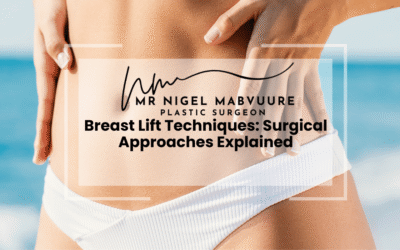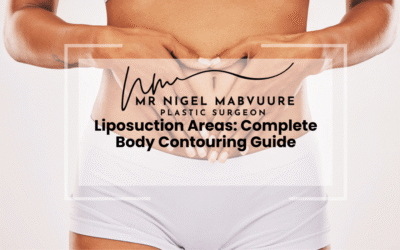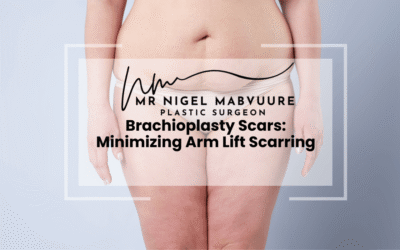What You Need to Know About Lipoabdominoplasty
- Lipoabdominoplasty combines liposuction with abdominoplasty to address both excess fat and loose skin, creating more comprehensive results than either procedure alone.
- Unlike traditional tummy tucks, this combined approach preserves more blood vessels, potentially improving safety and recovery outcomes while allowing for 360° contouring.
- Ideal candidates have both fat deposits and skin laxity, are within 10-15% of their ideal weight, and have realistic expectations about results.
- Recovery typically spans 3-6 months, with most patients returning to light activities within 2-4 weeks and experiencing final results as swelling completely resolves.
- While more expensive than individual procedures, lipoabdominoplasty offers better value through a single recovery period and more comprehensive, longer-lasting results.
- Advanced techniques like high-definition contouring and perforator vessel preservation continue to improve outcomes and expand options for personalized aesthetic results.
Table of Contents
- Understanding Lipoabdominoplasty: The Ultimate Abdominal Contouring
- How Lipoabdominoplasty Differs from Traditional Tummy Tucks
- Key Benefits of Combining Liposuction with Abdominoplasty
- Ideal Candidates for Enhanced Abdominoplasty Procedures
- What to Expect During Your Lipoabdominoplasty Recovery
- The Comprehensive Approach to Dual Abdominal Procedures
- Is Lipoabdominoplasty Worth the Investment?
- Advanced Techniques in Combined Body Contouring
Understanding Lipoabdominoplasty: The Ultimate Abdominal Contouring
Lipoabdominoplasty represents the pinnacle of abdominal contouring procedures, combining the fat-reducing benefits of liposuction with the skin-tightening and muscle-repairing advantages of a traditional abdominoplasty (tummy tuck). This innovative dual approach addresses multiple aesthetic concerns simultaneously, offering patients comprehensive results that neither procedure could achieve independently.
The technique was developed to overcome limitations of conventional tummy tucks, which primarily focus on removing excess skin and tightening abdominal muscles but may not adequately address fat deposits in the flanks, upper abdomen, and other surrounding areas. By integrating targeted liposuction, lipoabdominoplasty creates more harmonious body contours with improved definition.
During this procedure, your surgeon first performs liposuction to remove stubborn fat deposits from the abdomen, flanks, and sometimes the upper back or thighs. This strategic fat removal helps sculpt the waistline and create a more defined silhouette. Following liposuction, the abdominoplasty portion addresses loose skin and separated abdominal muscles (diastasis recti), which commonly occur after pregnancy or significant weight fluctuations.
This combined body contouring approach has revolutionised abdominal aesthetic surgery by delivering more natural-looking results with improved safety profiles and potentially shorter recovery times compared to performing the procedures separately.
How Lipoabdominoplasty Differs from Traditional Tummy Tucks
Traditional abdominoplasty and lipoabdominoplasty share the fundamental goal of improving abdominal aesthetics, but their approaches and outcomes differ significantly. Understanding these distinctions is crucial when considering which procedure might best address your specific concerns.
A conventional tummy tuck primarily focuses on removing excess skin and tightening the abdominal muscles. The surgeon makes a horizontal incision along the lower abdomen, excises redundant skin, repairs separated muscles, and repositions the remaining skin for a smoother appearance. While effective for skin laxity and muscle separation, traditional abdominoplasty has limitations in addressing fat deposits, particularly in the flanks and upper abdomen.
Lipoabdominoplasty, by contrast, begins with strategic liposuction of the entire abdominal region, including areas traditional tummy tucks cannot effectively treat. This comprehensive fat removal creates a more three-dimensional improvement by contouring not just the front of the abdomen but also the sides and potentially the back. The enhanced abdominoplasty portion then addresses skin excess and muscle laxity with potentially less undermining of tissues, which may contribute to improved blood supply and healing.
Another key difference lies in the preservation of perforator blood vessels during lipoabdominoplasty. These vessels supply blood to the abdominal skin flap, and their preservation—made possible through modified surgical techniques—can reduce complications and support better healing outcomes compared to traditional approaches.
The combined lipo tummy tuck approach also typically allows for more precise sculpting of the entire midsection, creating more natural-looking transitions between the abdomen, waist, and surrounding areas for a harmonious overall result.
Key Benefits of Combining Liposuction with Abdominoplasty
The integration of liposuction with abdominoplasty offers numerous advantages that have made lipoabdominoplasty increasingly popular among both patients and surgeons. These benefits extend beyond purely aesthetic improvements to include potential advantages in recovery and overall satisfaction.
One of the primary benefits is comprehensive contouring. By addressing both excess fat and loose skin simultaneously, lipoabdominoplasty delivers more complete transformation of the abdominal region. The procedure can effectively treat the entire torso circumference, including problematic areas like love handles and back rolls that a standard tummy tuck cannot address.
Improved definition is another significant advantage. The strategic removal of fat deposits before skin tightening allows surgeons to create more defined waistlines and natural-looking contours. This approach can highlight anatomical features like the linea alba (the central abdominal line) and rectus muscles, creating the coveted athletic appearance many patients desire.
The combined procedure also offers practical benefits, including a single recovery period. Rather than undergoing separate surgeries with multiple healing phases, patients experience one recovery process. Additionally, lipoabdominoplasty may reduce certain risks associated with performing the procedures separately, as the modified techniques often preserve more blood supply to tissues.
Many patients also report higher satisfaction rates with combined procedures, as the results tend to be more dramatic and harmonious. The comprehensive approach addresses multiple concerns simultaneously, creating balanced proportions throughout the midsection rather than improving one aspect while leaving others untreated.
Ideal Candidates for Enhanced Abdominoplasty Procedures
Determining whether you’re an appropriate candidate for lipoabdominoplasty requires careful consideration of several physical and lifestyle factors. While this combined procedure offers remarkable benefits, it isn’t suitable for everyone seeking abdominal improvement.
Ideal candidates typically present with both excess abdominal fat and skin laxity. This common combination often results from significant weight loss, pregnancy, or natural ageing processes. If you have good skin elasticity with primarily fat concerns, liposuction alone might be sufficient. Conversely, if muscle separation and skin excess are your primary concerns with minimal fat deposits, a traditional tummy tuck might be more appropriate.
Health considerations play a crucial role in candidacy assessment. Suitable candidates should be in good overall health, non-smokers (or willing to quit well before surgery), and within approximately 10-15% of their ideal body weight. Lipoabdominoplasty is not a weight loss procedure but rather a body contouring solution for those who have already achieved relative weight stability.
Psychological readiness is equally important. Candidates should have realistic expectations about potential outcomes and understand that while dramatic improvements are possible, results vary based on individual anatomy and tissue quality. They should also be prepared for the recovery process, which requires time and adherence to post-operative guidelines.
Women who have completed their families make particularly good candidates, as future pregnancies can compromise surgical results. However, the procedure can be appropriate for those who haven’t had children but understand that subsequent pregnancies might necessitate revision surgery.
During your consultation, your surgeon will evaluate these factors comprehensively to determine whether lipoabdominoplasty or an alternative approach would best achieve your aesthetic goals.
What to Expect During Your Lipoabdominoplasty Recovery
Recovery from lipoabdominoplasty requires patience and careful adherence to your surgeon’s guidelines. Understanding the typical recovery timeline and expectations can help you prepare mentally and logistically for this transformative but demanding process.
The immediate post-operative period (1-2 weeks) typically involves moderate discomfort managed with prescribed pain medication. You’ll likely be discharged with surgical drains to prevent fluid accumulation, and you’ll need to wear a compression garment continuously to reduce swelling and support healing tissues. During this initial phase, walking slightly bent at the waist is normal as your tissues adjust to their new position. Limited mobility is expected, and you’ll need assistance with daily activities.
By weeks 2-4, most patients experience significant improvement in comfort levels. Drains are typically removed within the first two weeks, depending on output volumes. Many can return to light desk work around the two-week mark, though strenuous activities remain restricted. The compression garment continues to play an essential role in optimising your results and should be worn as directed, usually for about 4-6 weeks total.
The intermediate recovery phase (4-8 weeks) brings progressive improvement in mobility and comfort. Most patients can gradually resume light exercise around 4-6 weeks, though abdominal-focused workouts should be avoided until cleared by your surgeon. Swelling continues to subside, though some residual swelling, particularly in liposuctioned areas, is normal and may fluctuate throughout the day.
Complete recovery typically takes 3-6 months, with final results becoming apparent as all swelling resolves and tissues settle. Scars will continue to mature and fade for up to a year or longer. Throughout your recovery, attending all follow-up appointments is crucial for monitoring your healing progress and addressing any concerns promptly.
The Comprehensive Approach to Dual Abdominal Procedures
The success of lipoabdominoplasty lies in its methodical, multi-dimensional approach to abdominal contouring. This comprehensive strategy addresses all layers of the abdominal wall—from superficial fat to deep musculature—creating harmonious results that isolated procedures cannot achieve.
The procedure typically begins with a thorough pre-operative assessment and marking phase. Your surgeon will carefully map out areas for liposuction, skin excision, and muscle repair while you’re standing, as body positioning significantly affects how tissues distribute. This meticulous planning ensures balanced, natural-looking results.
During surgery, the process generally follows a strategic sequence. First, liposuction targets subcutaneous fat throughout the abdomen, flanks, and sometimes extending to the back or upper thighs. This initial fat removal allows your surgeon to better visualise the underlying muscular structure and determine precise skin excision requirements. The selective preservation of fat in certain areas, particularly around the rectus muscles, can enhance definition and create more athletic-looking contours.
Following liposuction, the abdominoplasty portion addresses skin excess and muscle separation. Modern techniques often employ selective undermining rather than the extensive tissue elevation used in traditional approaches. This selective method preserves more perforator blood vessels, potentially reducing complications and supporting better healing.
The dual abdominal procedure may also incorporate additional refinements such as umbilical repositioning, creation of natural-looking abdominal etching, and careful management of the transition zones between treated and untreated areas. These details contribute significantly to the natural appearance of the final result.
This layer-by-layer, circumferential approach exemplifies how modern body contouring has evolved from simply removing excess tissue to artistically reshaping the entire midsection for optimal aesthetic outcomes.
Is Lipoabdominoplasty Worth the Investment?
When considering lipoabdominoplasty, many patients naturally question whether the procedure justifies its cost, which typically exceeds that of either liposuction or abdominoplasty performed individually. This investment consideration encompasses not only financial aspects but also recovery time and potential risks.
From a financial perspective, lipoabdominoplasty generally represents better value than undergoing separate procedures. While the combined approach costs more than either individual procedure, it’s typically less expensive than the cumulative cost of having liposuction and abdominoplasty performed separately. Additionally, you’ll experience only one anaesthesia fee, one facility fee, and one recovery period, creating both cost and time efficiencies.
The comprehensive results achieved through lipoabdominoplasty often deliver higher satisfaction rates than isolated procedures. Patients frequently report that the dramatic transformation of their entire midsection—rather than improvement of just one aspect—provides significant psychological benefits, including enhanced body confidence and expanded clothing options. These quality-of-life improvements, while difficult to quantify, represent substantial value for many patients.
Longevity of results also factors into the investment equation. When performed on appropriate candidates who maintain stable weight and healthy lifestyle habits, lipoabdominoplasty results can be remarkably durable. The removed fat cells do not regenerate, and the tightened muscles and excised skin create improvements that often last for many years, though natural ageing will continue.
When evaluating whether lipoabdominoplasty is worth the investment, consider your specific aesthetic goals, budget constraints, and how significantly your abdominal concerns affect your quality of life. For patients with both significant skin laxity and fat deposits who desire comprehensive improvement, the combined procedure typically offers excellent value despite its higher initial cost.
Advanced Techniques in Combined Body Contouring
The field of combined body contouring continues to evolve, with surgeons developing increasingly sophisticated techniques to enhance safety, reduce recovery time, and improve aesthetic outcomes. These advanced approaches have transformed lipoabdominoplasty from simply combining two procedures into a refined surgical art form.
High-definition lipoabdominoplasty represents one of the most significant advancements. This technique goes beyond basic fat removal and skin tightening to create athletic-looking abdominal definition. Using specialised cannulas and precise fat removal patterns, surgeons can highlight natural muscular anatomy, creating visible rectus abdominis borders, linea alba, and even “six-pack” definition in appropriate candidates. This approach requires exceptional artistic vision and technical skill but can deliver remarkably sculpted results.
Preservation of perforator vessels has revolutionised the safety profile of combined procedures. Traditional abdominoplasty techniques often involved extensive undermining that compromised blood supply to the abdominal skin flap. Modern approaches selectively preserve these crucial blood vessels, potentially reducing complications like tissue necrosis and improving healing outcomes. This vascular-aware approach has made lipoabdominoplasty suitable for a broader range of patients.
Progressive tension suture techniques represent another significant advancement. These internal stitches eliminate the need for drains in many cases by closing dead space between tissue layers and distributing tension throughout the repair rather than concentrating it at the incision line. This approach can reduce seroma formation (fluid collection) and potentially improve scar quality.
Non-surgical adjuncts increasingly complement surgical procedures. Technologies like radiofrequency skin tightening or targeted muscle stimulation may be recommended before or after lipoabdominoplasty to enhance skin quality or muscle definition, creating more comprehensive results than surgery alone can achieve.
These advanced techniques highlight how modern lipoabdominoplasty has evolved into a sophisticated, customisable procedure that can be tailored to each patient’s unique anatomy and aesthetic goals.
Frequently Asked Questions
How long does lipoabdominoplasty surgery take?
Lipoabdominoplasty typically takes 3-5 hours to complete, depending on the extent of correction needed and the surgeon’s technique. This combined procedure is longer than either liposuction or abdominoplasty alone because it addresses both fat removal and skin/muscle tightening in one comprehensive surgery.
Is lipoabdominoplasty more painful than a traditional tummy tuck?
Lipoabdominoplasty is not necessarily more painful than a traditional tummy tuck, though recovery experiences vary by patient. Many surgeons report that the selective undermining techniques used in lipoabdominoplasty may actually result in less postoperative discomfort compared to traditional methods. Pain is typically well-managed with prescribed medication during the first 1-2 weeks after surgery.
How much weight will I lose with lipoabdominoplasty?
Lipoabdominoplasty typically removes 2-5 pounds of tissue, though this varies by individual. However, it’s important to understand that this procedure is not a weight loss solution but rather a body contouring method. The visual improvement often appears much more significant than the actual weight removed because the procedure creates improved proportions and eliminates bulges that clothing may not conceal well.
When can I exercise after lipoabdominoplasty?
After lipoabdominoplasty, patients can typically resume light walking within days of surgery, light cardio activities around 4-6 weeks, and full unrestricted exercise including core workouts by 8-12 weeks. This gradual return to activity depends on individual healing progress and should always be guided by your surgeon’s specific recommendations during follow-up appointments.
Will lipoabdominoplasty remove stretch marks?
Lipoabdominoplasty can remove stretch marks located on the excised skin below the navel, but cannot eliminate stretch marks in areas where skin is preserved, such as above the navel or on the sides. The procedure may make remaining stretch marks less noticeable by tightening the skin, but patients should have realistic expectations about stretch mark improvement.
How visible will the scars be after lipoabdominoplasty?
Lipoabdominoplasty scars typically include a horizontal line across the lower abdomen (designed to be concealed by underwear or swimwear) and a small scar around the repositioned navel. While initially red and raised, these scars generally fade significantly over 12-18 months. Liposuction portions of the procedure leave only tiny puncture marks that become nearly imperceptible over time.
Can I combine lipoabdominoplasty with other procedures?
Lipoabdominoplasty can often be safely combined with complementary procedures such as breast surgery (creating a “mommy makeover”), arm lifts, or thigh contouring. However, there are limits to how many procedures can be performed safely in one surgical session, typically based on total operative time and the amount of tissue being treated. Your surgeon will assess your overall health and desired outcomes to determine appropriate procedure combinations.




